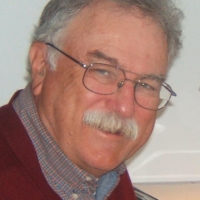Just over half a century ago, Paul Robeson and William L. Patterson, two giants of the struggle for African-American equality, delivered to the United Nations a petition titled “We Charge Genocide: The Crime of Government Against the Negro People.”
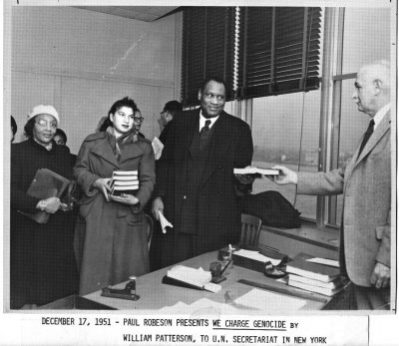
Robeson was accompanied by signers of the petition Dec. 17, 1951, when he presented the document to a UN official in New York. The same day, Patterson, executive director of the Civil Rights Congress (CRC), which had drafted the petition, delivered copies to the UN delegates meeting in Paris.
“Out of the inhuman Black ghettos of American cities,” the introduction began, “out of the cotton plantations of the South, comes this record of mass slayings on the basis of race, of lives deliberately warped and distorted by the willful creation of conditions making for premature death, poverty and disease … ”
Jarvis Tyner, executive vice chair of the Communist Party USA, says the power of the petition was its expose of culpability in genocide by the ruling circles in the U.S. “The federal government claimed it had nothing to do with the lynchings. But this petition said: ‘You knew about it and you did nothing. You knew about the super-exploitation and inhuman hardships inflicted upon the Black people and you did nothing. Your inaction, your indifference in the face of oppression means that it was policy.’”
Among the signers were the eminent African-American historian and freedom fighter Dr. W.E.B. DuBois, George Crockett Jr., later a distinguished judge in Detroit who went on to serve many terms in the U.S. Congress, New York City Communist councilman Benjamin J. Davis, Jr., Ferdinand Smith, Black leader of the National Maritime Union, Dr. Oakley C. Johnson of Louisiana, Aubrey Grossman, the labor and civil rights lawyer, and Claudia Jones, a Communist leader in Harlem later deported under the witch-hunt Walter-McCarran Act. Also signing were family members of the victims of “legal lynching”: Rosalee McGee, mother of Willie McGee, framed up on rape charges, and Josephine Grayson, whose husband, Francis Grayson, was one of the Martinsville Seven, framed and executed on false rape charges in Virginia.
In the section titled “Evidence,” hundreds of cases of lynching were documented. The petition charged that since the abolition of slavery at least 10,000 Black people had been lynched. The full number, it stated, will never be known because the murders were often unreported.
The petition exposed a conspiracy to deny Black people the right to vote through poll taxes, literacy tests and outright terrorism. It brings to mind the “vote scrubbing” of 87,000 Black voters in Florida that enabled George W. Bush to steal the 2000 election.
Strom Thurmond, then South Carolina governor, was listed in the rogues’ gallery. He had run for president on the segregationist Dixiecrat Party ticket in 1948. The petition quoted Thurmond denouncing the Fair Employment Practices Act requiring equal pay for equal work as “patterned after a Russian law written by Joseph Stalin.” Thurmond scorned a proposed law against lynching as “tyranny. What could be more un-American?”
George W. Bush and Sen. Trent Lott (R-Miss.) toasted Thurmond at his 100th birthday bash in Washington a few weeks ago. Lott told the crowd the country would have been “better off” if Thurmond had been elected president. This racist remark touched off a furor that forced Lott to step down as Senate Majority Leader, but it also laid bare the poisonous racism of the Republican Party.
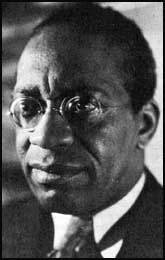
Patterson, a leader of the Communist Party USA, was an eminent civil rights attorney who had defended Sacco and Vanzetti. He spearheaded defense of the Scottsboro Nine, Black youth in Alabama framed up on phony rape charges in 1932. Patterson wrote in his autobiography, The Man Who Cried Genocide, that he had just returned from Richmond, Va., where he had struggled without success to save the Martinsville Seven, also falsely accused of raping a white woman.
“To me, it seemed clear that the Charter and Conventions of the UN had to be made the property of the American people as far as possible and especially of Black America,” Patterson wrote. “It could be made the instrumentality through which the ‘Negro Question’ could be lifted to its highest dimension.”
The UN Convention on the Prevention and Punishment of the Crime of Genocide, adopted Dec. 9, 1948, flowed from the determination of the world community that never again would fascism be allowed to plunge humanity into holocaust and world war. Patterson pointed out that the U.S. stubbornly refused to ratify the convention even as American officials boasted of U.S. “democracy” and lectured other nations on human rights abuses, a “do as I say, not as I do” posture. (The U.S. did not ratify the Genocide Convention until Sen. William Proxmire (D-Wisc.) finally pushed it through the U.S. Senate in 1987.)
The “prime mover” in the genocide against the African-American people “is monopoly capital,” the petition charged. “Monopoly’s immediate interest is nearly four billions of dollars in superprofits that it extracts yearly from its exploitation and oppression of the Negro people …” The racist wage differentials inflicted on Black workers drives down the wages for workers of all races, the petitition charged. Despite gains for the African-American people, that wage differential continues today to pour tens of billions in extra profits into corporate bank accounts each year.
The petition answered the argument that “genocide” refers only to physical extermination, citing the UN’s definition: “Any intent to destroy, in whole or in part, a national, racial, or religious group is genocide.” The petition continued, “We maintain, therefore, that the oppressed Negro citizens of the United States, segregated, discriminated against, and long the target of violence, suffer from genocide as the result of the consistent, conscious, unified policies of every branch of government … If the General Assembly acts as the conscience of mankind and therefore acts favorably on our petition, it will have served the cause of peace.”
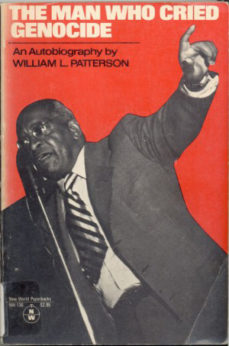 The courageous act of Robeson and Patterson ignited a firestorm with Cold Warriors slurring them as “traitors” in the service of the Soviet Union.
The courageous act of Robeson and Patterson ignited a firestorm with Cold Warriors slurring them as “traitors” in the service of the Soviet Union.
The attempts to silence Patterson began while he was in Paris. Packages with copies of the petition sent to London and Paris never arrived. He had brought twenty copies in his luggage and had sent 60 more to Budapest. He called Budapest and friends there expressed them back to him.
All the UN delegates received a copy. During a recess at the Palais de Chaillot where the UN was meeting, Dr. Channing Tobias, a U.S. delegate, chided Patterson for “this attack upon your government.” Patterson snapped, “It’s your government. It’s my country. I am fighting to save my country’s democratic principles.”
Later, Eleanor Roosevelt, head of the U.S. delegation, delivered a speech, attempting to answer the charges without mentioning the petition. When Patterson arrived back in the U.S., federal agents hustled him into a room and strip-searched him, the first of many acts of retaliation.
The charge of disloyalty was aimed at diverting attention from the irrefutable evidence in the petition. Yet the Cold Warriors could not hold back the rising tide of outrage against racist segregation enforced by lynch terror. The “We Charge Genocide” petition was only the opening shot. The Supreme Court’s Brown v. Board of Education decision in 1954 inflicted a huge blow on the system of legal segregation by reversing the Plessy v. Ferguson doctrine of “separate but equal.” The high court ruled that “separate is inherently unequal.” Then came Rosa Parks’ refusal to move to the back of the bus in Montgomery, Ala., and the boycott that followed. The floodgates of the civil rights revolution were opened.
Jean Damu, chair of the California Coalition for H.R.-40, the reparations bill introduced by Rep. John Conyers (D-Mich.), wrote recently that the “We Charge Genocide” petition “may be seen as much the ideological stimulus for the civil rights movement as Brown v. Board of Education,” and “must be seen as the seminal act.” Damu points out that while the petition did not call for reparations, “here for the first time in regards to African-Americans, a crime is charged and documented, a victim is specified and a perpetrator is pinpointed.”
Robert Taylor, a spokesperson for “Millions for Reparations,” based in Brooklyn, N.Y., likewise hailed the “We Charge Genocide” petition as an antecedent of the struggles to win reparations for the African-American people for centuries of slavery, genocide and continued oppression today.
“Think of all the police killings of Black people in which the white officers were exonerated,” Taylor said, citing the case of Amadou Diallo who died in a hail of 41 bullets fired by eight white New York City cops. “All the white police officers were exonerated. Consider the Central Park jogger case where those innocent young Black men spent 13 years in prison for a crime they didn’t commit. Yes, things have changed, but the essence remains the same.”
The struggle against racist oppression has won many victories and made long strides toward equality. But contrary to the assertions of Bush and the ultra-right, the U.S. is far from the “color blind” oasis of “equal opportunity” they proclaim. There are more African Americans in prison than in college. A Human Rights Watch report revealed that Black men are imprisoned of drug offenses at an astounding rate of 1,146 per 100,000, thirteen times higher than the rate of 139 per 100,000 for white men. “This is nothing short of a national scandal,” the report charged.
During the past decade, an estimated 2,000 African Americans died at the hands of police, almost always white officers, the slaying invariably ruled “justifiable homicide.” The most recent is Michael Ellerbe of Uniontown, Pa., a 12-year-old Black youngster shot in the back by Pennsylvania state troopers just before Christmas. The troopers were exonerated by the State’s Attorney.
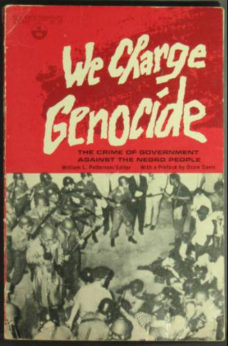 Jan. 1 was the 140th anniversary of the Emancipation Proclamation. Yet African-American life expectancy is 71.8 years compared to 77.4 years for whites. Infant mortality for African Americans is 14.6 per 1,000 live births compared to 5.8 per 1,000 live births for whites. In these two vital statistics, the gap between white and Black is once again widening.
Jan. 1 was the 140th anniversary of the Emancipation Proclamation. Yet African-American life expectancy is 71.8 years compared to 77.4 years for whites. Infant mortality for African Americans is 14.6 per 1,000 live births compared to 5.8 per 1,000 live births for whites. In these two vital statistics, the gap between white and Black is once again widening.
Last year, 1.3 million people fell below the poverty line. There are now 33 million poor people in the U.S., 7.8 percent white, 22.7 percent Black, and 21.4 Hispanic. Unemployment is at 6 percent and again the Black jobless rate is twice that of whites.
With his demagogic attack on affirmative action at the University of Michigan, falsely branding it “racial preferences” and “reverse discrimination,” Bush makes plain that he seeks to roll back the gains of the African-American people.
In his foreword to the 1970 edition of “We Charge Genocide,” Patterson wrote that “racism U.S.A. is an export commodity breeding aggressive wars and threatening the peace of the world … I assert that the wantonly murderous and predatory racist attacks on Korea, Vietnam and Cambodia … are inseparably related to the equally criminal murders of rebellious Black youth in Chicago … New Haven … Augusta, Georgia, and Jackson, Mississippi.”
Patterson could be writing about George W. Bush and his fanatical drive for war on Iraq. “We Charge Genocide” will continue to ring with the truth until racism is banished and the African-American people have won full equality.
The books “We Charge Genocide” and “The Man Who Cried Genocide” are available from International Publishers of New York.


